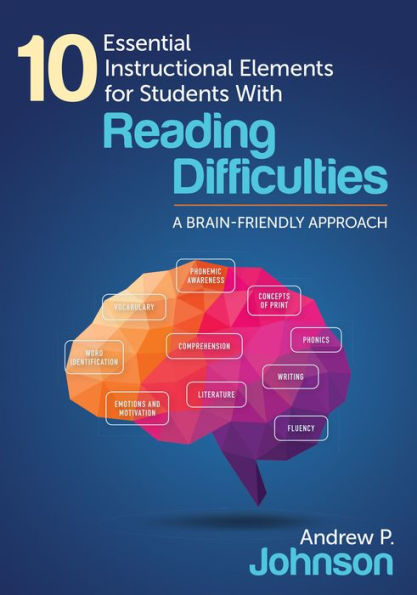Brain-friendly strategies to help all students become lifelong readers
Learning to read is more than just an educational issue; it’s a social justice issue. Did you know that struggling readers are twice as likely as their peers to drop out of high school? Through time-tested, research-based neurocognitive teaching strategies, 10 Essential Instructional Elements for Students with Reading Difficulties will enable you to hone readers’ skills and help students from all grade levels develop their ability to create meaning from print.
Drawing from five key areas of neurocognitive research, Andrew Johnson provides a ten-point teaching strategy that encompasses vocabulary, fluency, comprehension, writing and more. A key resource for creating intervention plans for struggling readers, features include:
- Information on the often-overlooked importance of emotions in the process of overcoming reading struggles
- Strategies to promote voluntary reading, even for the most reluctant students
- Useful resources such as graphic organizers, additional reading and writing activities, and QR codes that link to videos
- Use these strategies today and you can count on more students leaving your classrooms as fluent, lifelong readers.
Terry Bernstein, Former Senior Literacy Difficulties Specialist
London Boroughs of Camden and Westminster, UK
"This is the text I wish I had when I began to teach. Dr. Johnson clearly illustrates the process our brain uses to create meaning from text."
Marty Duncan, Ed.D., Author and Former Educator
Brain-friendly strategies to help all students become lifelong readers
Learning to read is more than just an educational issue; it’s a social justice issue. Did you know that struggling readers are twice as likely as their peers to drop out of high school? Through time-tested, research-based neurocognitive teaching strategies, 10 Essential Instructional Elements for Students with Reading Difficulties will enable you to hone readers’ skills and help students from all grade levels develop their ability to create meaning from print.
Drawing from five key areas of neurocognitive research, Andrew Johnson provides a ten-point teaching strategy that encompasses vocabulary, fluency, comprehension, writing and more. A key resource for creating intervention plans for struggling readers, features include:
- Information on the often-overlooked importance of emotions in the process of overcoming reading struggles
- Strategies to promote voluntary reading, even for the most reluctant students
- Useful resources such as graphic organizers, additional reading and writing activities, and QR codes that link to videos
- Use these strategies today and you can count on more students leaving your classrooms as fluent, lifelong readers.
Terry Bernstein, Former Senior Literacy Difficulties Specialist
London Boroughs of Camden and Westminster, UK
"This is the text I wish I had when I began to teach. Dr. Johnson clearly illustrates the process our brain uses to create meaning from text."
Marty Duncan, Ed.D., Author and Former Educator

10 Essential Instructional Elements for Students With Reading Difficulties: A Brain-Friendly Approach
256
10 Essential Instructional Elements for Students With Reading Difficulties: A Brain-Friendly Approach
256eBook
Related collections and offers

Product Details
| ISBN-13: | 9781506338330 |
|---|---|
| Publisher: | SAGE Publications |
| Publication date: | 10/09/2015 |
| Sold by: | Barnes & Noble |
| Format: | eBook |
| Pages: | 256 |
| File size: | 4 MB |
